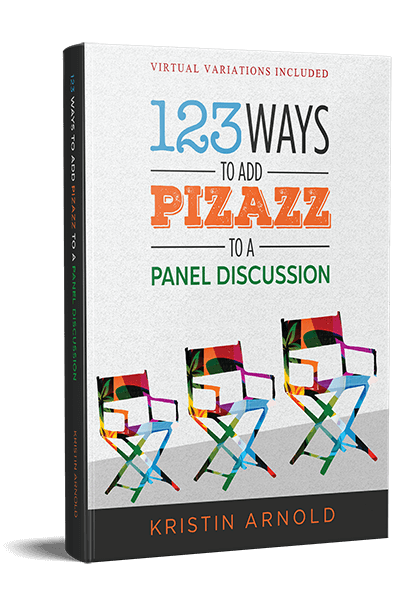
Kristin Arnold moderates a panel discussion at eCap Summit 2018 in Miami. In her new book, 123 Ways to Add Pizzazz to a Panel Discussion, Arnold writes that panel sessions at events are here to stay, even in the virtual environment.
If two out of three attendees dislike panel sessions, why do 95 percent of conferences and conventions feature some sort of panel on their program? Kristin Arnold doesn’t claim to have the definitive answer to that question — those stats are hers, by the way — other than panels continue to be a go-to format for event organizers, even for digital events. But she does have some ways to make panel discussions better: 123 of them, to be exact.
Arnold, president of Extraordinary Team and author of the recent 123 Ways to Add Pizzazz to a Panel Discussion, has been a meeting facilitator, professional panel moderator, and conference emcee for nearly three decades. A Master Certified Professional Facilitator (CPF-M), Arnold spoke at a Velvet Chainsaw webinar, “Rethink, Restart, Refresh Your Panels: Advice for 2021,” in January.

Expert moderator Kristin Arnold hopes her new book “will inspire you to upgrade your panels.”
Panel sessions, Arnold writes in the book’s preface, are here to stay, even in the virtual environment, despite the fact that most audiences don’t have high expectations for them. They still hope for a “’Wizard of Oz’ moment when the curtain is pulled back on a topic,” Arnold writes. “They are hoping the panelists will share their wisdom and insights. That there will be an element of surprise, of diverse viewpoints and provocative thinking. That it will be spontaneous and unscripted.”
Which is why, Arnold writes, she was asked to write this book — her “fervent hope,” she writes, is that the book “will inspire you to upgrade your panels.”
Here’s just one of her suggestions to shake up your next panel discussion, whether it’s in person, or online. One note: The underlying premise of this and the other 122 ideas is that an experienced moderator is key to their success.
#86: Rapid-Fire Panelist Polling
A technique to shift gears and change the pace: Take a rapid-fire poll of the panelists. Here are a few ways you can do this:
Rate from 1-10. Ask each of the panelists, on a scale of 1-10, 1 being the lowest and 10 being the highest, how they would rate BLANK (pick an issue). They MUST pick a number, don’t let them go into explaining why. It should be quick and easy. After all panelists have weighed in, you can make an observational comment (“Wow! We have a wide range here!”), decide to probe deeper into one panelist’s response, or continue with your next poll.
Yes/no/maybe. Create an interesting, closed question, such as: “Do you think this [future trend] is going to happen in the next five years? Yes, no, or maybe?” Note: I’ve known some to switch the “maybe” to “It’s complicated.” That’s up to you.
Fiver. In this poll, ask a question to the panelists and they must answer in five words (and it must be five words only). Encourage your panelists to use their fingers because it gets quite stressful, edgy, and fun! It’s also revelatory. They must be able to show brilliance in five words, in the moment, counting on their fingers while a bazillion people are staring at them. Note: There’s no face loss to struggle a little bit because everyone has placed themselves vicariously in the panelists’ position. They are thinking, “What would I do?”
Is it better? This poll requires panelists to answer quickly. Think of two things you know the organization doesn’t have complete agreement on. You want to know which side of the fence the panelists are on.
The one-breath rule. Ask the panelists a question and they can answer as long as they want in one breath. What normally happens when you are describing this new ground rule is they won’t believe you. So, when the first panelist starts to answer the question and takes his first breath, you must jump in. Just watch the rest of the panelists go “Whaaaaat?” The second panelist starts to panic and you’ll see the audience lean in to see what happens next.
With these rapid-fire polling techniques, you could rattle through a lot of questions and get a lot of interesting engagement from all panelists in a very short period of time.
Arnold includes notes at the end of many of the ideas in the book to make them more specific to an online platform. Here is her note at the end of this idea:
Because the panelists are not literally sitting next to each other, they will not normally know the order of the lineup unless you tell them. Ask them to keep their microphones on and remind them of the lineup. Repeat the question and let the polling begin. Don’t be surprised if you have to cue the next person to talk by simply stating their first name.
Michelle Russell is editor in chief at Convene.
